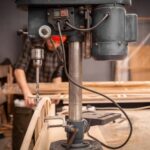Are you interested in exploring the world of woodworking and unleashing your creativity through craftsmanship? Whether you’re a complete beginner or have some experience with DIY projects, getting started in woodworking can be an exciting and rewarding journey. In this article, we’ll delve into the essential tools, safety precautions, lumber selection, basic techniques, workshop setup, project ideas for beginners, and additional resources to help you embark on your woodworking adventure. So, what do i need to start woodworking?
Woodworking is a versatile and fulfilling hobby that allows individuals to bring their visions to life through the manipulation of wood. From creating functional furniture pieces to intricate decorative items, the possibilities are endless with woodworking. Whether you aspire to build simple shelves or complex cabinets, knowing where to begin and understanding the necessary tools and techniques is crucial for success.
In the following sections, we will cover everything you need to know about starting your woodworking journey – from setting up a safe and efficient workspace to selecting the right materials for your projects. Additionally, we will provide inspirational ideas for beginner-friendly projects to kick start your woodworking endeavors. So let’s dive into the exciting world of woodworking and discover the potential it holds for creativity and craftsmanship.
Essential Tools
Starting woodworking can be an exciting and rewarding journey, but it’s essential to have the right tools to get started. Here is a comprehensive list of must-have woodworking tools for beginners:
- Measuring Tools: A tape measure, combination square, and marking gauge are essential for accurate measurements and layouts.
- Cutting Tools: A quality handsaw, chisels, and a block plane are necessary for cutting and shaping wood.
- Drilling and Fastening Tools: A cordless drill/driver with a set of bits, a hammer, and screwdrivers will help you assemble your projects effectively.
- Sanding Tools: Sandpaper in various grits, a sanding block, and an orbital sander are crucial for achieving smooth surfaces on your woodworking projects.
- Finishing Tools: A paintbrush or foam brush, along with a scrap piece of wood for spreading glue or finish, will aid in applying stains or finishes to your creations.
In addition to hand tools, power tools can significantly speed up your woodworking projects. Consider investing in the following power tools:
- Table Saw: Ideal for making straight cuts on large pieces of wood or sheet goods.
- Router: Great for creating decorative edges or joinery in woodworking projects.
- Miter Saw: Perfect for making accurate crosscuts and miter cuts in wood.
It’s important to remember that while these tools are essential for getting started in woodworking, it’s also crucial to prioritize quality over quantity. Investing in high-quality tools will save you time and frustration in the long run.
Remember that building your collection of woodworking tools often happens gradually as you tackle new projects. Start with the basics and expand your tool arsenal as you gain experience and take on more advanced woodworking tasks.
Safety Precautions
When starting woodworking, it is crucial to prioritize safety in your workspace. Below are some important safety measures and equipment that you need to ensure a safe woodworking environment:
- Protective Gear: Always wear the appropriate protective gear when working with wood, including safety goggles, ear protection, and a dust mask to protect yourself from sawdust and flying wood particles.
- First Aid Kit: Keep a well-stocked first aid kit in your workshop at all times in case of accidents or injuries.
- Fire Safety: Have a fire extinguisher within easy reach in your workshop and take precautions to prevent sawdust or wood shavings from accumulating around potential ignition sources.
Additionally, it is important to follow these safety precautions while working with woodworking tools:
- Tool Maintenance: Regularly inspect and maintain your hand tools and power tools to ensure they are functioning properly and safely.
- Proper Tool Usage: Take the time to familiarize yourself with each tool’s proper usage and safety guidelines before using them for woodworking projects.
- Workshop Layout: Organize your workspace in such a way that there is ample lighting, ventilation, and clear pathways to prevent accidents.
By prioritizing safety measures and investing in the necessary equipment, you can create a safe and secure woodworking environment for yourself as you embark on this new creative journey. Always remember that taking the time to implement these safety measures will allow you to focus on honing your woodworking skills without compromising your well-being.
Selecting Lumber
When starting out in woodworking, one of the most important decisions you will make is choosing the right type of wood for your projects. The type of wood you select can significantly impact the outcome of your project, so it’s essential to understand the different characteristics of various wood species and how they will affect your finished piece.
Understanding Wood Characteristics
Before selecting lumber for your woodworking project, it’s crucial to understand the different characteristics of wood species. Some woods are known for their strength and durability, making them suitable for furniture-making, while others may be prized for their natural beauty and grain pattern, ideal for decorative pieces or fine woodworking. Understanding these characteristics will help you choose the right wood for your specific project.
Types of Wood
There are many different types of wood available for woodworking, each with its unique properties. Hardwoods such as oak, maple, cherry, and walnut are commonly used in furniture-making due to their strength and attractive grain patterns.
On the other hand, softwoods like pine and cedar are popular choices for outdoor projects and construction due to their affordability and ease of workability. Additionally, there are exotic woods with unique colors and grains that can add a special touch to your projects.
Tips for Choosing Lumber
When selecting lumber for your woodworking projects, it’s important to consider factors such as moisture content, straightness, and any defects such as knots or cracks. Additionally, think about how the wood will interact with finishes and joinery methods. By carefully considering these factors when choosing lumber, you can ensure that your projects turn out beautiful and durable.
Basic Woodworking Techniques
Measuring
Accurate measurements are crucial in woodworking to ensure that your projects fit together perfectly. To start woodworking, you will need a measuring tape, combination square, and marking tools such as pencils and marking knives. These tools will allow you to measure and mark your wood accurately before making any cuts or joining pieces together.
Cutting
One of the essential skills in woodworking is the ability to make precise cuts. To achieve this, beginners will need basic cutting tools such as a handsaw or circular saw for straight cuts, and a coping saw or jigsaw for curved cuts. Additionally, investing in a quality table saw can greatly improve the efficiency and accuracy of your cuts.
Jointing
Joinery techniques are used to connect two pieces of wood to form a strong bond. Common jointing techniques for beginners include the butt joint, dado joint, and rabbet joint. To create these joints, you will need basic hand tools such as chisels, mallets, and hand planes. As you progress in woodworking, you may also consider investing in power tools such as a router for more advanced joinery.
Finishing
The finishing process is essential to protect your woodworking projects and enhance their appearance. Beginners should have sandpaper of various grits for smoothing surfaces, as well as brushes or spray equipment for applying finishes such as paint or varnish. Understanding different finishing techniques and products is key to achieving professional-looking results in your woodworking projects.
By mastering these fundamental woodworking techniques, beginners can lay the foundation for creating beautiful and functional woodworking projects. As you gain experience and confidence in these skills, you’ll be able to tackle more complex projects and expand your creativity in the world of woodworking.
Setting Up a Workshop
When starting woodworking, one of the essential aspects to consider is setting up a workshop. Having a functional workspace is crucial for any woodworking project, as it can affect your efficiency and safety. Before diving into your projects, it’s important to carefully plan and organize your workshop to make the most out of your woodworking experience.
First and foremost, you will need a designated area for your woodworking activities. Whether it’s a garage, basement, or a dedicated shed, having a space where you can work undisturbed is important. Consider factors such as lighting, ventilation, and access to power outlets when choosing a location for your workshop.
Once you have chosen the perfect spot for your woodworking shop, the next step is to start organizing your tools and materials. Investing in storage solutions such as shelving units, cabinets, and tool chests can help keep your workspace tidy and efficient. Proper organization not only saves time but also reduces the risk of accidents by preventing tripping over clutter or misplacing sharp tools.
Beyond just tools and materials, consider how you will set up your workbench and any additional work surfaces needed for larger projects. It’s important to have enough space to move around comfortably while working on your projects. A well-organized workshop not only enhances productivity but also contributes to a safer working environment.
| Workshop Organization | Importance |
|---|---|
| Designated area | Allows for undisturbed work |
| Storage solutions | Reduces risk of accidents and saves time |
| Adequate workspace | Enhances productivity and safety |
Project Ideas for Beginners
Woodworking is an incredibly rewarding hobby that allows individuals to unleash their creativity and craftsmanship. For those who are new to woodworking, it can be overwhelming to figure out where to start and what tools are needed. However, with the right guidance and inspiration, beginners can embark on exciting projects that will help them develop their skills and build confidence in working with wood.
One of the simplest yet satisfying projects for beginners is building a basic wooden shelf. This project only requires a few essential tools such as a saw, drill, measuring tape, and sandpaper. By following step-by-step instructions and using pre-cut lumber from the hardware store, beginners can easily create a functional shelf to display their favorite items while honing their woodworking skills.
Another great project idea for novice woodworkers is crafting a cutting board. Not only is this project practical, but it also introduces beginners to the process of gluing boards together, cutting precise angles, and applying a food-safe finish. With careful attention to detail and the right tools, including a planer and wood glue, beginners can achieve impressive results that they can proudly use in their kitchen or give as a thoughtful handmade gift.
For those interested in exploring more advanced techniques early on, building a simple wooden bench provides an excellent opportunity for skill development. While this project may require additional tools such as chisels and clamps, it offers beginners the chance to practice joinery methods like mortise-and-tenon or dovetail joints. With dedication and patience, novice woodworkers can create a sturdy and attractive bench that showcases their growing proficiency in woodworking.
| Project Idea | Tools Needed |
|---|---|
| Basic Wooden Shelf | Saw, drill, measuring tape, sandpaper |
| Cutting Board | Planer, wood glue |
| Wooden Bench | Chisels, clamps |
By beginning with these achievable projects and gradually expanding their repertoire of skills and tools required for woodworking craftspeople are sure to enjoy years of creative fulfillment in this timeless craft.
Additional Resources
In conclusion, woodworking is a fulfilling and rewarding hobby that allows for endless creativity and the opportunity to create functional and beautiful pieces. As you venture into the world of woodworking, it’s important to start with the right tools and safety measures in place to ensure a successful and enjoyable experience.
When considering what do I need to start woodworking, it’s crucial to prioritize safety equipment such as goggles, ear protection, and a dust mask, as well as essential hand tools like chisels, hammers, saws, and clamps.
Additionally, selecting the right lumber for your projects is key to achieving the desired results. Whether it’s hardwood or softwood, understanding the characteristics of different wood species can greatly impact the outcome of your work. Learning basic woodworking techniques such as measuring, cutting, jointing, and finishing is essential for success in your projects. As you develop your skills, setting up a workshop with practical organization and storage solutions will further enhance your productivity and enjoyment of woodworking.
As you continue on your woodworking journey, there are numerous resources available for further learning and exploration in this craft. Books, websites, online forums, and community resources provide valuable information, tutorials, project ideas, and inspiration for woodworkers at every skill level.
Whether you’re interested in traditional woodworking methods or modern techniques utilizing power tools, there is a wealth of knowledge waiting to be discovered. Embrace the journey of woodworking with an open mind and a desire to learn – the possibilities are endless.
Frequently Asked Questions
Can I Teach Myself Woodworking?
Yes, it is definitely possible to teach yourself woodworking. There are numerous resources available such as books, online tutorials, and instructional videos that can help you learn the basic skills and techniques. It may take time and practice, but with dedication, it is achievable.
How Do I Start Woodworking With No Experience?
Starting woodworking with no experience can be daunting, but it’s important to begin by familiarizing yourself with basic tools and their uses. Consider starting with small, simple projects to build confidence and gradually work your way up to more complex ones. Seeking guidance from experienced woodworkers or joining a beginner’s woodworking class can also be beneficial.
How Do I Start Woodworking From Scratch?
To start woodworking from scratch, it’s essential to first gather the necessary tools and materials. Then, familiarize yourself with safety practices before tackling any project. Next, pick a simple project that aligns with your skill level and follow step-by-step instructions carefully. As you gain more experience, you can move on to more challenging projects.

Hi everyone! I’m a woodworker and blogger, and this is my woodworking blog. In my blog, I share tips and tricks for woodworkers of all skill levels, as well as project ideas that you can try yourself.





